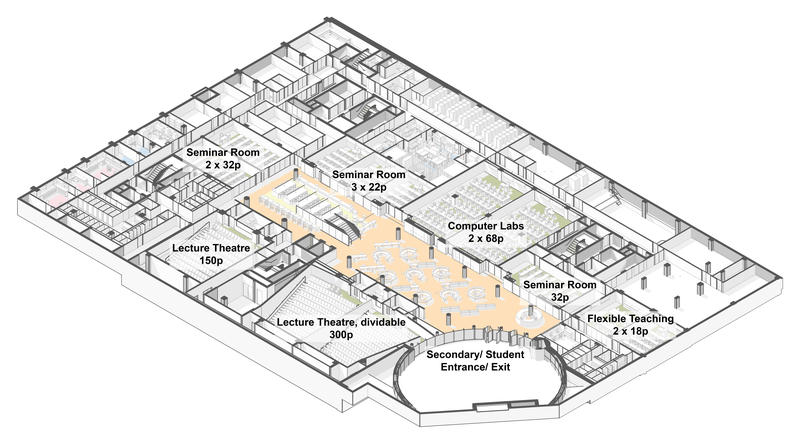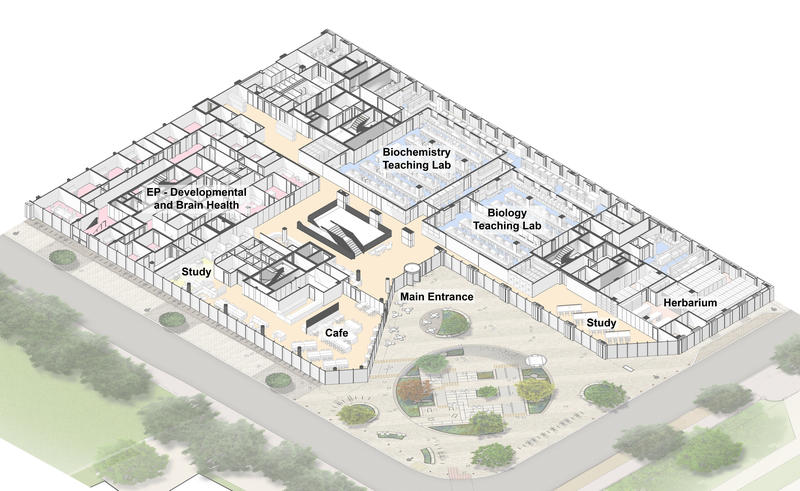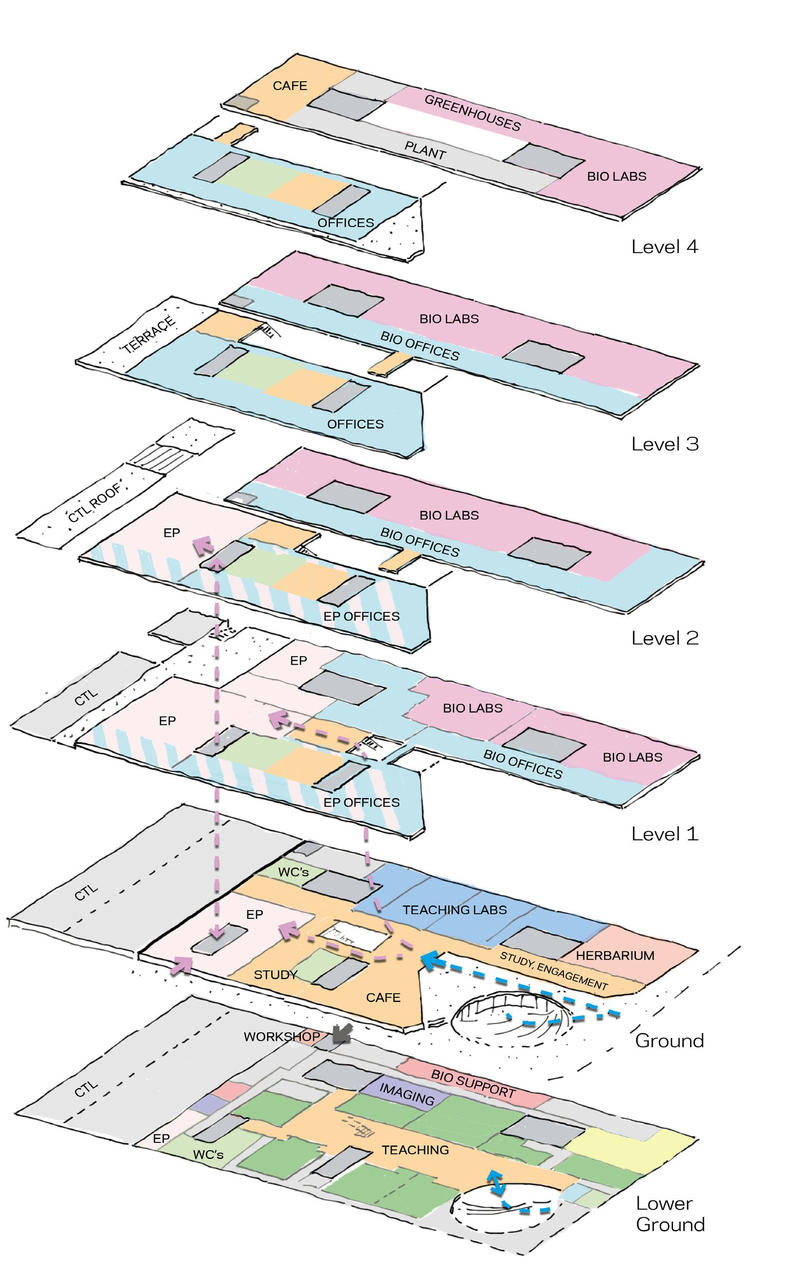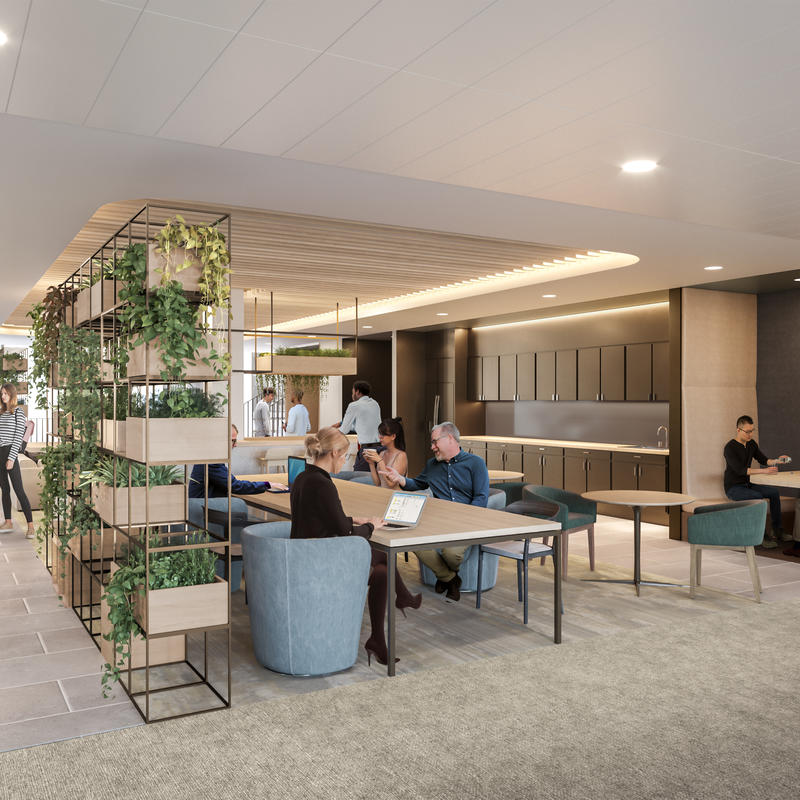Functional Organisation
The organisational concept and resulting layouts are key to accommodating required functional areas while balancing height and impact on the Oxford skyline with the provision of a public space within the site boundaries that draws in the public, links to University Parks, and ensures daylight reaches occupied space.
Lower Ground - Teaching
Key to managing the bulk of the building and to enable this public plaza is the introduction of a full basement that provides quality functional space.
The concept successfully locates teaching facilities in the basement. Measures to provide good daylight and access to this area give the impression of a lower ground floor instead of a basement. A sunken courtyard provides access and external space to the lower ground floor as well as allowing students to enter and exit the building at peak time without congesting the main entrance at ground level.

Lower Ground Floor
Ground Floor - Engagement
On the ground floor, the main entrance, reception, a café, study spaces and exhibition/engagement zones animate the frontages facing the public plaza and St Cross Road. A Herbarium housing valuable collections of plants will be accessible by prior arrangement and exhibit items of its collection. Its windows facing South Parks Road are being studied to host exhibits or digital media while allowing light into the interior at a high level.
Also at ground level and accessible from the main entrance, volunteers who participate in Department of Experimental Psychology research can reach one of two dedicated receptions - with the ground floor reception dedicated to younger children and the elderly visiting the building.
A discreet private entrance on St Cross Road will also enable the Department to welcome a small number of vulnerable volunteers who benefit from being able to avoid crowds for mental health reasons.
Laboratories designed for teaching complete the programme at ground level. Windows between arrival space and the teaching laboratories allow glimpses into the world of science.

Ground Floor
Upper Floors - Research and Collaboration
With teaching and public functions located at ground and lower ground, the upper floors are dedicated to research staff and their activities. Layered security arrangements allow limited access for visitors and students to the terraced levels in the atrium, the roof terrace at Level 3 and the Level 4 café. The café at level 4 with panoramic views towards the city centre is also planned to be available for events by prior booking.
Approximately 1450sqm of unallocated (shelled) space split between level 1 (suitable for laboratories and offices) and in the lower ground (suitable for high spec labs and/or teaching space) provide a sustainable strategy for future growth and variations in brief.
The atrium terrace at level 1 is publicly accessible via stairs and acts as arrival space for volunteers attending Experimental Psychology research space. From here, via a security barrier, stairs allow staff and researchers to access further terraces at Level 2 and 3, provide shared break-out, meeting and study space.
Floors in the ‘flex block’ are designed to suit the performance requirements of a range of laboratory types and allow technical space and write-up offices to flex in size. This arrangement provides great flexibility to adapt to changing requirements over time.
Layouts in the office block are suitable for office environments as well as experimental psychology research space.
In both blocks secondary functions like stairs, lifts and toilets have been placed in the centre of the floor plate, maximising occupied space near the perimeter and atrium.
At level 4 of the flex block, a café takes advantage of the panoramic views towards Oxford city centre and hills beyond. The rest of the floor is occupied by greenhouses and associated research space as well as the required mechanical and electrical plant required to service a world class research facility.
Health and Wellbeing
Access to nature, daylight and views are critical to enhancing occupants’ wellness as well as productivity and creativity. Wayfinding and the ability to quickly orientate and understand a space are also key to reducing stress while generating a stimulating experience with a rich choice of environments that have been shown to enhance wellbeing and alertness.
The design ensures constant presence and access to nature, external space, views and daylight. Massing and orientation maximise views out to the large trees along with South Parks and St Cross Road, and the green belt beyond.
Further, the design and layout of the Life and Mind Building aims to stimulate people’s movement via stairs instead of lifts by providing walkable routes along desired lines and by locating shared enjoyable facilities and amenities at various points throughout the building rather than in one place, adding physical activity to an occupant’s day. At the same time, the arrangement of lifts ensures that all building areas remain fully accessible and within easy reach to anyone who can not negotiate stairs.
Where functional requirements do stipulate a highly cellularised room layout, as with the windowless testing booth for Experimental Psychology, the design ensures as far as possible that circulation routes run along the building perimeter with windows and break-out pockets offering respite.

Stacked Floor Plan

View of shared break-out space looking towards the atrium.

Shared atrium break-out space on Level 2.


